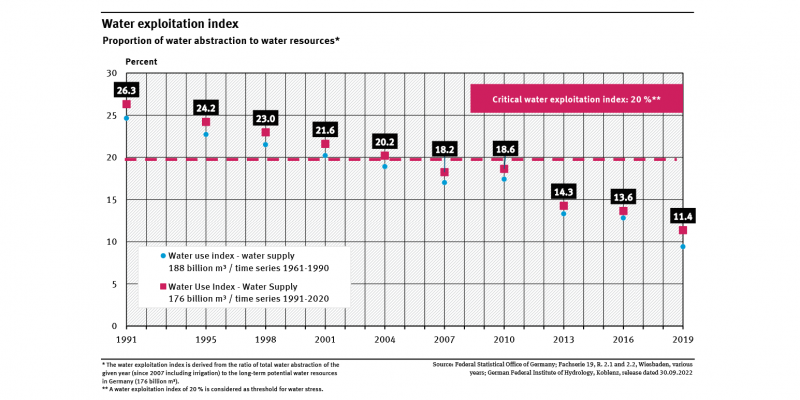Indicator: Using water resources
 Click to enlarge
Click to enlargeSource: Federal Statistical Office of Germany Figure as PDF
 Umweltbundesamt
Umweltbundesamt
 Click to enlarge
Click to enlarge
- A water exploitation index of 20 % or above indicates the threshold of water stress.
- Water stress means an increasing risk of environmental problems and economic difficulties.
- Since 2007 the water exploitation index has been below the critical level of 20 %.
- Germany is causing water exploitation in other parts of the world by importing goods. In some regions this can contribute to water stress.
The water exploitation index shows the level of water abstraction in Germany, measured against the renewable water resources. The renewable water resources or the renewable water supply are presented as long-term potential water supply. The renewable water resources in Germany comprise 176 billion m³ determined for the period 1991 -2020. A use of 20 % or more of the renewable water resources is considered as water stress in international terms. Using too much water can lead to environmental problems and hinder economic development (Raskin et al. 1997). For instance, groundwater resources near the coast can become saline due to the penetration of seawater. Falling groundwater levels can lead to the drying out and loss of marshes and wetlands or forests can be damaged.
Although there is no water stress in Germany on average, there are regional and seasonal differences. Precipitation is very unevenly distributed in Germany. Regions such as Brandenburg and Saxony-Anhalt have particularly low precipitation. Other regions, e.g. the Alpine foothills, have high levels of precipitation.
The indicator should have a regional reference added in future. This would enable the water exploitation index to be specifically identified on a regional basis and regions with potential water stress could be shown. Indicators of this kind are currently being developed.
In its Roadmap to a Resource Efficient Europe the European Commission has set a target of not exceeding the 20 % threshold value for the water exploitation index (EC 2011). In Germany the index fell from 26.3 % to 11.4 % between 1991 and 2019. The reason for this development is a continuous decline in water abstraction in Germany. In 1991 it was still 46.3 billion cubic metres (m³) while in 2016 it was about 57 % less, at 20.0 billion m³.
Large amounts of the water volume are used for cooling and are returned into lakes or rivers after use. If this is included in the calculation, then the water exploitation index would be considerably below 10 %. The sharp fall in water abstraction between 2010 and 2013 was largely due to the lower use of cooling water in conventional power plants.
In Germany itself, there is no water stress on average. However, the German economy contributes to water usage in other countries through the import of water-intensive goods. This can cause water stress in some places, depending on the local conditions.
The indicator compares water abstraction with potential water resources. Calculating the water resources includes inflow from other countries and the difference between precipitation and evaporation from soils and plants. The mean of the period from 1991 to 2020 is used for calculating the index. To allow comparison with the previous climate period 1961-1990, the water exploitation index is additionally calculated and presented using the renewable water supply for the period 1961 to 1990.
For comparison, the mean of potential water resources for the period 1961-1990 are calculated and also shown in the figure. Water abstraction is recorded by the Federal Statistical Office of Germany and published every three years in the ‘Fachserie 19 Reihe 2.1.1 and 2.2’ (in German only). These technical series also include guidelines on collecting the data. Potential water resources are determined via the water balance by the Federal Institute of Hydrology (BfG).
More detailed information: 'Wasserressourcen und ihre Nutzung' (in German only).